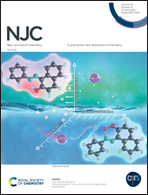Design and synthesis of berberine loaded nano-hydroxyapatite/gelatin scaffold for bone cancer treatment†
Abstract
The treatment of osteosarcoma, as the most destructive bone cancer, is allied with many challenges. One of the new tissue engineering approaches is the use of a local drug delivery system implanted after surgery. This system can be a scaffold mimicking the natural tissue extracellular matrix, loaded with drugs. Therefore, the purpose of this study was to construct different berberine-loaded nano-hydroxyapatite/gelatin scaffolds, and to investigate their effects on osteosarcoma cancer cells. The scaffolds after fabrication were analyzed for physicochemical properties using XRD, EDS, FTIR, and FE-SEM. The drug loading and release, and the biocompatibility (MTT and LDH) were also evaluated. Moreover, apoptosis, viability, colony formation, and scratch tests were conducted on cancer cells. The scaffolds exhibited a porosity of 66.64% with pore sizes of 10–70 micrometers. The results showed that the released berberine had a cytotoxic effect on cancer cells (cell death of ∼38–80% based on LDH, and cell proliferation <56% and <21% in terms of early and late exposure based on MTT). The apoptosis results revealed a remarkable increase in the percentage of apoptotic MG63 cells after treatment with berberine-loaded scaffolds in a dose-dependent manner. All scaffolds with berberine were able to significantly prevent colony formation and cell migration (only 9.7–15.7% closure).



 Please wait while we load your content...
Please wait while we load your content...